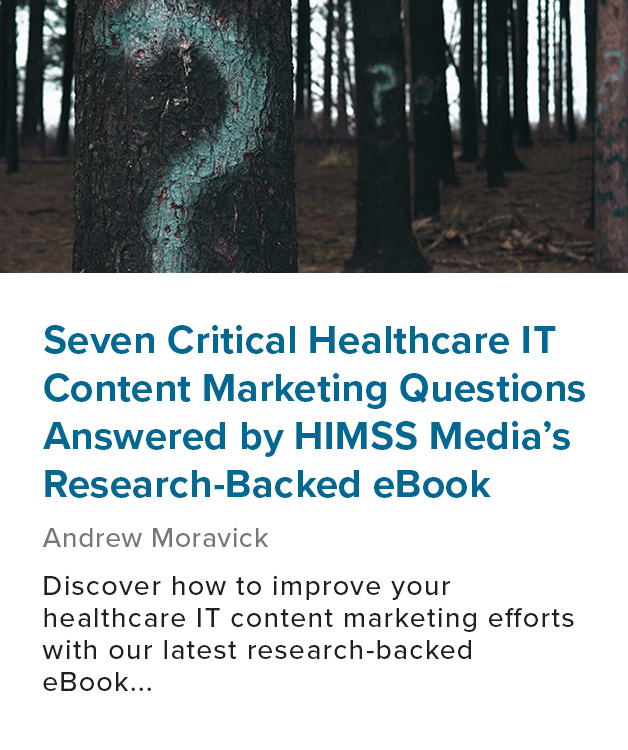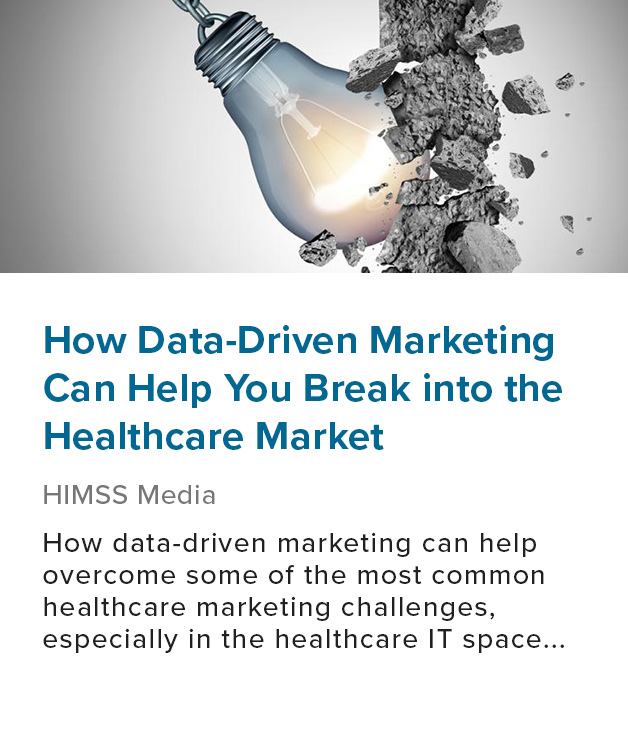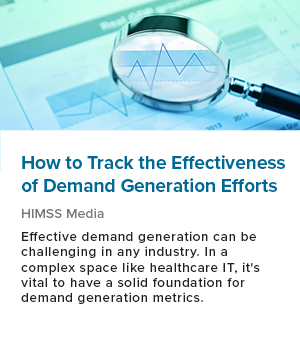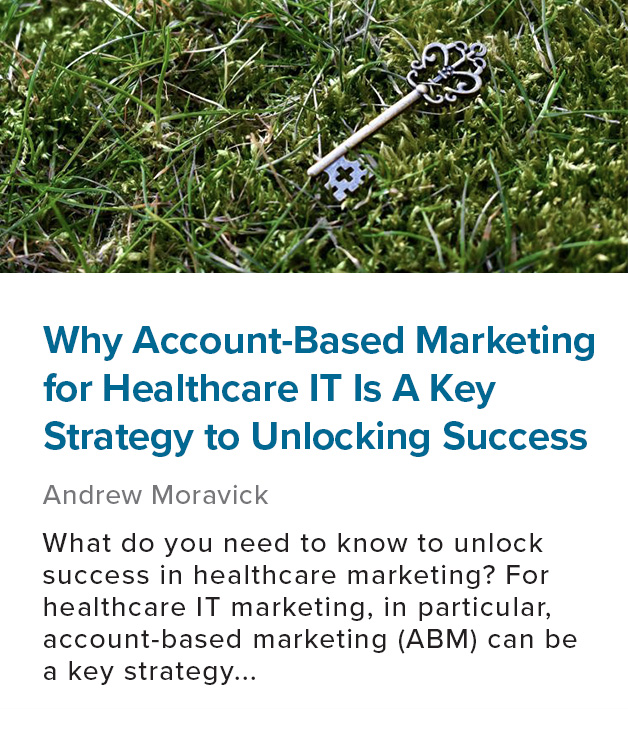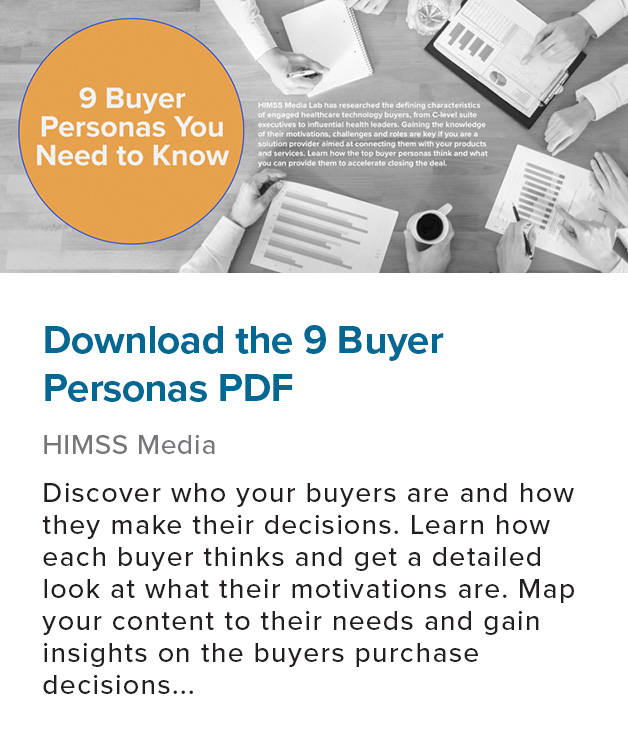
Account-Based Marketing in Healthcare
What is Account-Based Marketing?
A Coordinated Marketing Strategy for Target Accounts
At HIMSS Media, we define account-based marketing (ABM) as:
"A marketing methodology for identifying, understanding, and engaging accounts in order to cultivate awareness or further interest among the key stakeholders of an account’s buyer collective which is conducive to initial, retained, or even expanded business relationships."
In its most simple terms, account-based marketing is a targeted approach to market to specific key accounts. It is about marketing to all decision makers — either all at once or in a strategic order — to build and nurture the right customer relationships. With ABM, you engage and influence your key accounts and their associated personas through customized, multi-channel programs designed to drive specific outcomes.
Combining Key Features of Other Strategies
ABM pulls together the strands of different marketing strategies and weaves them into a cohesive tapestry, drawing on a variety of marketing fundamentals across the board.
Inbound marketing is vital for understanding your environment, orienting your messages to buyers and adding value for your customers. By creating personalized engagements for your accounts and speaking to the personas within each account, ABM employs the mindset and content practices of inbound marketing on a large scale.
However, ABM also draws on the methods of outbound marketing, directly addressing prospects rather than waiting for organic leads. ABM employs outbound approaches, such as emails to target lists or account-focused digital advertising, to enable a larger impact. You directly promote content to your accounts; when prospects engage, you trigger more inbound-oriented nurture campaigns.
ABM finds a perfect balance between the two approaches. You may be targeting specific accounts, but with an effective inbound mindset, you'll be producing materials that those accounts would want to find regardless. In a sense, you want to directly invite your accounts (outbound) to target you for answers and view you as a trusted source of relevant information (inbound).
More Than the Sum of Its Parts
Account-based marketing is built on two core components: data insights and content marketing. But ABM is much more than those particular tools.
ABM is a comprehensive methodology to organize your marketing efforts.
The true value of ABM lies in the fact that it coordinates a variety of marketing activities and strategies — including both inbound and outbound — within one optimized structure. As a result, it is extremely effective for complex buyer collectives or large-scale campaigns within a particular vertical, such as healthcare.
The ABM Methodology
ABM is a powerful tool for complex industries and a comprehensive methodology for marketing. But how is an ABM campaign created? What does this system look like?
On a basic level, an ABM strategy entails:
- Identifying target accounts, or businesses you want to sell to
- Researching those accounts to identify the buyer personas and key players in the buyer collective
- Formulating a hypothesis based on your observations about which marketing tactics will be most effective
- Implementing those tactics (especially content offerings), personalizing for the account profile
- Documenting the impact and effect of those methods
- Reiterating, improving and finding data-based trends based to identify what works best
- Aligning your marketing and sales departments to ensure a smooth lead handoff
- Expanding this model to lookalike accounts, personalizing as needed
These steps, however, are not discrete pieces that can be adopted or discarded at will. Individual tactics do not comprise a strategy. To effectively execute and fully reap the benefits of ABM, the entire system of account-based marketing must be maintained, from preparation to execution and beyond.
The Prep Work
Align Marketing and Sales
Before building a campaign, you need to start with the plumbing. A good pipe flow between marketing and sales is essential to a seamless ABM campaign. Coordinate across the two departments to determine lead flow handoff definitions, persona journeys and funnels, consistent brand and product messaging and more. Many experienced marketing teams even have a client success component dedicated to this coordination.
This alignment should also extend to identifying target accounts. The process of creating a list of target accounts must be cooperative, involving marketing, sales and any other stakeholders with relevant insight. Alignment ensures that the right accounts are targeted with the right message — and every member of your team knows how to deliver that message as part of a cohesive whole.
Set Expectations
Implementing account-based marketing is not a simple task. It's not a switch that can be flipped. Your team must have reasonable expectations for the execution and success of early ABM programs. ABM relies on content and data, both of which can't be created overnight.
Dig into your current resource and knowledge base with questions like:
- Do you have content that relays the messages you want to send for each persona?
- What data can you currently access regarding similar campaigns or your target accounts?
- Can you find patterns in your existing data to guide your initial efforts?
- Do you have adequate resources to dissect the data you plan to collect?
In the HIT industry, which is infamously hard to break into, these expectations are crucial for long-term success — you simply may not succeed on your first few attempts.
Partner with Experienced Providers
Experienced providers are a powerful tool to add to your arsenal. Partners can expedite the process of creating and running an ABM campaign, supplement your content resources, augment your data analysis and more. Partners are essential, particularly within the complex field of HIT, for both their reputational weight and their depth of knowledge.
The Tools
Tool #1: Content Marketing
If ABM is the engine, content is the fuel that powers that engine. Content is what enables you to create those essential personalized experiences. It fuels the inbound aspects of an ABM campaign. ABM organizes how content is distributed in a scalable way. Effective content pushes personas across the finish line.
Content backed by solid research, geared toward key personas and optimized for ABM campaigns is a crucial tool for the success of ABM.
Tool #2: Data Insights
More than any other marketing strategy, ABM relies on in-depth data insights. Data analysis should inform every decision within ABM, including defining account profiles, finding demonstrable trends, iterating on successful efforts and learning from unsuccessful ones.
At its core, ABM operates like a scientific experiment: hypotheses, trials, data collection and analysis, new hypotheses, rinse and repeat. It's a process that allows your marketing to continually improve over time, growing and changing with the needs of complex industries like HIT.
|
|
|
Implementing an ABM Strategy
You've heard it before, but it's important to emphasize: ABM is a comprehensive methodology. As such, it's only successful when you follow every step and support conclusions with evidence.
In fact, in many ways, an ABM campaign operates in line with the scientific method. Science isn’t science if some aspects of the scientific method are used, but not all. It’s not a scientific venture without research, hypothesis creation and testing, documentation of results and replication paired with the other observe-and-conclude steps.
As a useful means for scoping out the key tenets of ABM, these core elements actually fit nicely into the steps of the scientific method:
1. Observe target accounts and account characteristics.
In its simplest form, this observation starts with the creation of a target account list. However, over time, behaviors and firmographics common to accounts can yield new lookalike accounts, additional stand-alone divisions of existing accounts, and more.
Observing means perceiving and registering what’s significant. An organization’s defined account list will always have gaps or missed opportunities if it's static and unresponsive to what makes an account worth targeting based on the patterns, behaviors and preferences of the people at the targeted accounts.
2. Research to identify the people who make up the buyer collective at an account.
In chemistry, an account would be an element, the buyer collective would be a molecule of that element, and the people comprising the buyer collective would be the specific atoms. While accounts are the objects of interest, people are still the fundamental units. Understanding how people within an account function as a buyer collective is vital for effectively converting those accounts.
3. Construct a hypothesis and plan for leveraging account insights.
There should be no “ifs” in ABM without defined “thens” attached to them. A hypothesis/plan doesn’t have to be any more complicated than this:
- If X people at an account all consume Y content assets, then that account is ready for action Z.
- If types of content are meant to nurture buyers at defined stages of the purchase process, then accounts with final-stage content consumption should close at a higher rate.
- If you do the things you expect to move the needle, then needle movement should move in this expected, quantifiable way.
4. Test the hypothesis with content designed to appeal to buyer needs in the intended ways.
From a scientific standpoint, content is meant to be a stimulus – just as light, the smell of food or a sudden motion might prompt an organism to react, content should prompt a reaction from a target individual, or from its account at large. You should already have scoped out the purpose of each piece of content in your hypothesis. At this point, all you have to do is send it to the people it's meant for, through the channels it's been designed for.
5. Capture the results of interactions to objectively understand account reactions.
This is, perhaps, the most valuable element of ABM, but also the easiest to overlook. Leads, impressions, or other success metrics that you pursue in your ABM plan are great to achieve, but if you’re documenting your results, they’re also valuable if they’re not achieved.
No matter what, a true ABM program allows you to learn about what matters to your accounts, and the people therein, and what is just noise. Make sure these insights are used to deliver just as much value as the desired outcomes.
6. Conclude what’s working with accounts, and what’s not.
Replicate what works broadly, or for each account, and revisit what’s not. If any result is valid, it should be able to be duplicated. In marketing, duplicating, and even predicting, desired results – increased pipeline, greater marketing ROI, sure-win opportunities – is a huge advantage. ABM should allow you to recycle efforts for predictable, repeatable results while incrementally reducing how much time and money is lost to dead ends. Thus, ABM is ongoing, and should be ever-improving.
It’s important to note: success or failure against these hypotheses isn’t success or failure in the business sense. You don’t lose if the hypothesis isn’t validated. Instead, you understand that what you thought would move the needle, didn’t. You can move on to finding what will accomplish your goals without wasting any more time or effort.
In short, if you want the full advantages of ABM — and in health IT marketing, a comprehensive ABM strategy is essential — you must be prepared to follow the full methodology, meaning you must see the value in so-called failure.
An Innovative Healthcare Marketing Idea
Marketing in the healthcare space, and particularly within health information technology (HIT), is challenging for a few crucial reasons:
- There's a complex buyer collective
- Personas are siloed with limited communication
- Every organization has a unique purchasing model
Account-based marketing solves for the unique challenges of health IT marketing with its tactical use of data, content, inbound and outbound methods.
1. Simplify the complex buyer collective.
In HIT, the average buyer collective comprises nine distinct personas, often with limited time and contrasting priorities. Two or three of those people are direct decision makers who rely on the opinions of the other role players. They also operate in vastly different roles, from IT to finance to patient services to legal. Needless to say, it's a buyer collective that's challenging to market toward consistently and effectively.
ABM helps to simplify this collective by tracking patterns and creating replicable models across key accounts with similar buyer collectives. Account-based marketing in healthcare relies on in-depth data insights, such as identifying the true priorities of each persona; these vital insights allow you to break down the complexity. ABM also enables you to directly message to each player with personalized content.
2. Facilitate engagement from siloed personas.
This grouping of personas is by no means united. Often, they are segmented into different realms of expertise and with minimal intercommunication. As a result, you need robust and targeted customer engagement strategies. You also need a multi-branch system for buyer engagement and awareness, to meet each buyer along their intertwined buyers' journeys.
ABM provides that system by creating personalized experiences for each buyer. Additionally, by targeting key accounts under the umbrella of a cohesive messaging strategy, ABM facilitates conversations among these personas, encouraging communication to unite these buyers.
3. Personalize and replicate for unique purchasing models.
With ABM, you don't have to reinvent the wheel. Each account may have its own unique purchasing model — but strong data analysis will reveal patterns across accounts. You'll be able to identify lookalike accounts, and when you know the account, you know the grouping you need to target.
ABM also involves strong account research before crafting those personalized experiences. You'll identify the right inroads of communication and the key priorities of each persona to turn a complex buying process into a manageable system.
Moreover, healthcare is a surprisingly small world, particularly HIT. Certain roles are rare. As you identify patterns, you'll identify the impact of each role or individual. You'll also learn about and iterate on the importance of peers who influence the purchase process.
Opportunities within HIT are sporadic and challenging. ABM enables you to pull all these complex threads together and break down the overwhelming, confusing morass of healthcare buying into an approachable target. From there, you can create marketing plans built to address these idiosyncrasies in a repeatable, scalable way.
Conquer These Challenges With a Partner
Even with the best strategies and tactics, both ABM and healthcare marketing are difficult to get right. For instance, it's one thing to know your buyer collective, and quite another to have content and messages teed up that will speak to each persona effectively. Without adequate experience, unique purchasing models can stymie marketers and make it difficult to identify true lookalike accounts. With time, you may get to know key peers and advisors within HIT, but you'll have to develop those insights from the ground up.
Instead, boost your account-based marketing efforts by working with a partner experienced in HIT. Established organizations will have both industry insights and reputational advantages. A partner can negate many of the roadblocks that complicate a new ABM campaign.
HIMSS Media's ABM Solutions
Understanding the ins and outs of account-based marketing is one thing. Creating and implementing an effective ABM campaign is something else entirely. If you're looking for some expert guidance, or simply need a boost to get your ABM efforts off the ground, we're here to help.
Our healthcare marketing services leverage all the power of account-based marketing strategies. Whether you’re focused on gathering account and persona intelligence, penetrating target accounts, creating personalized customer experiences, optimizing marketing spend or improving alignment between sales and marketing, HIMSS Media will work with you to implement an account-based marketing healthcare program that achieves your objectives.
Spread your message
Our clients can utilise any of our audience channels — digital display, native advertising, content syndication, HIMSS TV, social media, email, HIMSS Global Conference, custom events and more — to distribute messages and support thought leadership.
Get to know your customers
Our clients can take advantage of the industry’s largest first-party data set of healthcare technology buyers. Through the fully integrated HIMSS Audience Intelligence Platform (AIP), clients can receive unparalleled insights into key account activities across all audience channels.
Formulate a strategy with our ABM programs
Our data and marketing experts will help you create deeper, more engaging and efficient multi-channel campaigns with a variety of programs:
ABM Momentum
This turnkey solution is a great first program for those who are newer to ABM or are beginning to establish their presence in the healthcare industry. We'll help you create brand awareness among target accounts with tailored client messaging.
ABM Topic Affinity
This sustained thought leadership program aligns your brand to a specific topic covered by HIMSS editorial, driving deep topic engagement with your key targets. It provides account and buyer intelligence around topic affinity and related topics of interest; it can also be customized to complement your existing ABM activities, delivering data directly to your CRM.
ABM Journey
This targeted, multi-channel program uses a blend of HIMSS editorial assets and your thought leadership content to engage target account personas. Beginning with an audit of your content and a campaign strategy, this highly customized approach is designed for ABM teams looking to nurture buyers and influencers in key accounts with high value content through multiple touchpoints. The program also provides real-time reporting and direct CRM integration.

